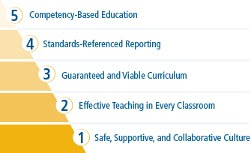“What are you really proud of, and what’s making you crazy?”
West Ada Superintendent Mary Ann Ranells asks her team a lot of questions. She listens and gathers information. The question above was her way of ascertaining some of the things that were frustrating her team, and some things they thought were going well.
What she found was frustration around the Professional Learning Community process in the District. As a large, fast-growing district, PLC members were increasingly feeling isolated and collaboration was suffering. Even though Richard DuFour’s popular model had been implemented in the District for some time, there was a need to “revive PLC”, in Superintendent Ranells’ words.
So, at a [PLC] conference in Arizona, Ranells expressed her team’s frustration to old friend Robert Marzano, who recommended that West Ada look at High Reliability Schools. Ranells asked a team of West Ada principals and district administrators to visit with Marzano. The team left the visit with a vision for systemic school improvement across 55 schools focused on research-based indicators, stakeholder transparency, and targeted professional development.
Superintendent Ranells and her team credit district-wide implementation of the High-Reliability Schools framework with the revitalization of the PLC strategy in the district, and with improving collaboration and communication in West Ada. The framework has provided a common language of effective school improvement practice and strengthen school cultures where high levels of learning are valued above all else.

The HRS framework is based on evidence-based practices where schools demonstrate successful completion of improvement indicators in the five areas outlined in the model above, beginning with “Safe, Supportive, and Collaborative Culture” and proceeding to “Competency-Based Education”. In 2018-19, after certifying all schools in the first level Safe, Supportive, and Collaborative Culture, West Ada’s Continuous Improvement Plan now includes a goal focused on High-Reliability Schools and states By May 1, 2021, 100% of West Ada schools will qualify for Effective Teaching in Every Classroom certification as measured by the District Certification Team review process and anchored to the academic measures of the West Ada Continuous Improvement Plan. District-wide progress toward their CIP goal is well underway.
The team that spoke to us indicated that they wanted to go beyond the ISAT and IRI in order to illustrate success in other areas. So West Ada is now using HRS surveys to gather valued input from staff, students, and parents to show status in many other areas of school improvement areas that impact student achievement, such as prioritizing standards. Priority Standards are in effect District-wide, but teachers have the wherewithal to establish how they instruct for those standards, staying within the “banks of the river” established by the District. The locally developed assessment provides assurance that students are on track for achievement on state-mandated tests.
Superintendent Ranells calls her administrative team “our wonderful learning leaders” and that was certainly evident in our conversations with this dynamic group. They are believers in the HRS system and have the evidence to feel confident it is helping West Ada reach its goals of continuous improvement.

